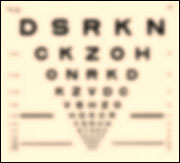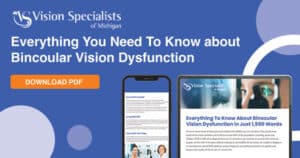 Community Outreach Manager Elli Altman started as a patient of Vision Specialists of Michigan. Now she teaches others how to identify a vision misalignment.
Having eyes that do not work together--do not coordinate; do not work as a team; are misaligned--however you want to phrase it--shows up in some of the oddest ways.
A patient may be referred to us (or make an appointment on their own) because of headaches, reading difficulty, anxiety, etc. However, it is the process that takes place during the vision exam that begins to reveal the mystery of just how many ways the patient has actually been impacted by this vision misalignment.
What do I mean? Well, it sounds like this...
--Oh, that's why I always knocked over the milk bottle when I reached for it at the dinner table.
--Oh, that's why I hate going to the mall (or any large store).
--Oh, that's why I'm fine driving on the side streets, yet panic on the highway.
--Oh, that's why my friends always tell me that I veer into them when we are out shopping.
--Oh, that's why it always felt like I was walking on a swaying hammock
--Oh, that's why I felt so uncomfortable making eye contact
--Oh, that's why I hated gym class and recess on the playground
This list is truly endless, as each person is impacted in novel ways. What is important to understand is that these revelations, this awareness, happens AFTER the vision exam and as a result of it.
I don't know anyone who thinks they need to get their eyes checked because they knocked over the milk bottle, hate going to the mall, doesn't like to drive on the highway—well, you get it.
So, if many of the clues that a person's eyes are not working together are understood only in hindsight, how do we get needed help to people?
That's easy. Take 10 minutes to answer 25 questions. That's all.
Go to www.IsItMyEyes.com. Complete the questionnaire with the 25 questions.
Maybe your mystery will be solved and you have your own "Oh, that's why" list.
Community Outreach Manager Elli Altman started as a patient of Vision Specialists of Michigan. Now she teaches others how to identify a vision misalignment.
Having eyes that do not work together--do not coordinate; do not work as a team; are misaligned--however you want to phrase it--shows up in some of the oddest ways.
A patient may be referred to us (or make an appointment on their own) because of headaches, reading difficulty, anxiety, etc. However, it is the process that takes place during the vision exam that begins to reveal the mystery of just how many ways the patient has actually been impacted by this vision misalignment.
What do I mean? Well, it sounds like this...
--Oh, that's why I always knocked over the milk bottle when I reached for it at the dinner table.
--Oh, that's why I hate going to the mall (or any large store).
--Oh, that's why I'm fine driving on the side streets, yet panic on the highway.
--Oh, that's why my friends always tell me that I veer into them when we are out shopping.
--Oh, that's why it always felt like I was walking on a swaying hammock
--Oh, that's why I felt so uncomfortable making eye contact
--Oh, that's why I hated gym class and recess on the playground
This list is truly endless, as each person is impacted in novel ways. What is important to understand is that these revelations, this awareness, happens AFTER the vision exam and as a result of it.
I don't know anyone who thinks they need to get their eyes checked because they knocked over the milk bottle, hate going to the mall, doesn't like to drive on the highway—well, you get it.
So, if many of the clues that a person's eyes are not working together are understood only in hindsight, how do we get needed help to people?
That's easy. Take 10 minutes to answer 25 questions. That's all.
Go to www.IsItMyEyes.com. Complete the questionnaire with the 25 questions.
Maybe your mystery will be solved and you have your own "Oh, that's why" list.
Filed Under:
Tagged With: bvd information,







